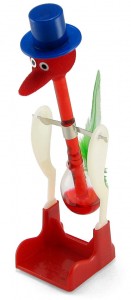If you put an ice cube in a glass of lemonade, the ice cube melts. The thermal energy from your lemonade moves to the ice cube. Increasing the temperature of the ice cube and decreasing the temperature of your lemonade. The movement of thermal energy is called heat. The ice cube receives heat from your lemonade. Your lemonade gives heat to the ice cube. Heat can only move from an object of higher temperature to an object of lower temperature.
We’re going to learn about temperature, heat energy, atoms, matter, phase changes, and more in our unit on Thermodynamics as we build steam boats, fire-water balloons, hero engines, thermostats, Stirling engines, and more!
NEW! Download the complete packet for this section here.
Does this sound familiar? “I’m too cold. Get me a sweater!” “This soup’s too hot!” “Phew, I’m sweating.” “Yowtch, that pan handle burned me!” If you’ve ever made any of the above comments, then you were talking about thermal energy. Very clever of you, don’t you think? Thermal energy is basically the energy of the molecules moving inside something. The faster the molecules are moving, the more thermal energy that something has. The slower they are moving, the less thermal energy that something has.
I’m sure at some point you’ve said, “Wow, my internal thermal energy is way high! I need a liquid with a low thermal energy.” What… you’ve never said that?! Oh, wait. I bet it sounded like this when you said it, “Wow, I’m hot! I need a cool drink.”
Whenever we talk about the temperature of something we are talking about its thermal energy. Objects whose molecules are moving very quickly are said to have high thermal energy or high temperature. The higher the temperature, the faster the molecules are moving. You may remember that temperature is just a speedometer for molecules.
You may have asked yourself the question, “So, if everything is made of molecules, and these molecules are often speeding up and slowing down…what happens to the stuff these molecules are are made of if they change speed a lot? Will my kitchen table start vibrating across the room if the table somehow gets too hot?” No, it’s pretty unlikely that your table will begin jumping around the room, no matter how hot it gets. However, some interesting things do happen when molecules change speeds.


